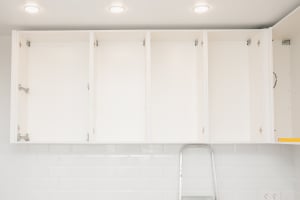Fire-rated interior doors are installed throughout buildings as an extra barrier to protect property and any employees, customers, or visitors who are in a building should a fire occur. Some fire doors are required by law, while others are recommended for extra protection.
Where Fire Doors Belong
Certain areas of an office building need more fire protection than others. For example, there could be a corporate office park that is home to a large pharmaceutical company.
Part of the building may be used for administrative purposes, but others might house laboratories that contain combustible materials used as part of their drug development efforts. These areas need extra security measures, such as securing the office space with office doors that are fire-rated.
Typical office areas that need fire-rated doors are:
Building and Floor Entrances and Exits
When there is a fire, people need a clearly-marked way to escape. Doors at entrances and exits need to be fire-rated to keep fire and smoke from spreading to other areas of the building.
Buildings That Are Connected
In urban areas and office complexes, it’s common for an organization to use multiple buildings that are connected. Placing fire-rated doors where the buildings meet allows for people to pass through during normal operations, and then close automatically to prevent fire from spreading during an emergency.
Elevators and Stairwells
Because elevators and stairwells are the primary way people get in and out of an office building, these doors need to be fire-rated to prevent fire and smoke from spreading to other floors. These doors can help expedite the flow of people leaving the building and emergency response personnel coming in to fight the fire.
High-Security Areas
Certain areas (such as mechanical rooms, kitchens serving employees and executives, special-use spaces like the laboratories with dangerous chemicals, etc.) need to be kept closed to the general public.
In these cases, heavier, fire-rated doors meet two needs. They can keep areas off-limits to those who don’t belong there, and they help contain fire, smoke, and toxic fumes if there is an accident.
What Do Fire Ratings Mean?
The National Fire Protection Association has hundreds of codes that apply to different types of doors in different settings. In general, the higher the rating, the better the doors are at standing up to heat and flames.
Fire doors are made from fire-resistant materials to slow down a fire. They also have intumescent seals that expand in high heat to prevent smoke from seeping through any gaps.
However, there is a difference between a fire-resistance rating and a fire-protection rating. Fire doors are rated according to how long they can hold up against fire, and even one hour of fire resistance is not the same as one hour of fire protection.
A 0.5-rated door can withstand thirty minutes of direct heat from a fire, while a 1.0-rated door can hold up for one hour, and a 3.0-rated door is secure for three hours. Of course, there are various ratings in between these examples.
Doors Help You Be Prepared
Fire can be devastating, and all office buildings need to comply with fire codes that are meant to prevent a fire from spreading. Investing in specially-designed fire doors is one way to keep people and property safe.
Fire doors may not be able to stop a fire completely, but they can slow it down long enough to give those inside valuable time to evacuate–and for the fire department to arrive before a fire gets out of control.
Regardless of the number of doors in a typical office building, safeguard your employees and business assets by contacting 27estore today to discuss your office layout and where you might need fire-rated or soundproof office doors!













